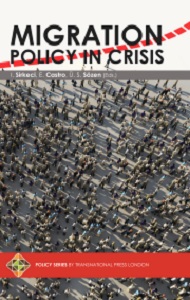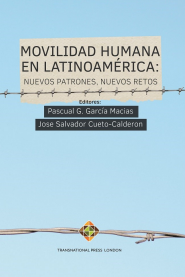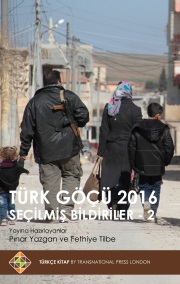
We kindly inform you that, as long as the subject affiliation of our 300.000+ articles is in progress, you might get unsufficient or no results on your third level or second level search. In this case, please broaden your search criteria.



The 2015 “migration crisis” has stimulated the European political imagination with an image of migration and border control as based on a mixture of humanitarianism and security. Indeed, the European borders and migratory routes have been increasingly framed in the media and political debates as the sites of a humanitarian and security emergency (see Dekker & Scholten, 2017; Greussing & Boomgaarden, 2017; Ibrahim & Howarth, 2017). The accounts of children dying in the Mediterranean have been reproduced together with images of uncontrollable crowds gathering at the borders, and again with overburdened reception centres with deplorable humanitarian conditions (see BBC, 2018; The Guardian, 2018; Reuters, 2018). All these framings have been (re)merging in the public debate, building a sense of humanitarian crisis, but also insecurity and uncertainty regarding the most suitable course of action at the European level. Regardless the European Union’s (EU) attempts to respond to the increased migratory flows, the humanitarian situation has been getting more severe, generating a political momentum for mobilization of more decisive, security-oriented and even militarized measures in dealing with the crisis. Consequently, the EU has decided to increase its operational and military presence in the Mediterranean with Frontexled Joint Operations (JO) (i.e. Triton, Poseidon and Themis) and Common Security and Defence Policy (CSDP) naval mission (i.e. EUNAVFOR MED Sophia), explicitly framing the mobilization of security capabilities as search and rescue and “live saving” operations.
More...
In 2015 and 2016, Germany faced an influx of asylum seekers on an unprecedented scale. How did the country react to this so-called “refugee crisis”? The response was a major effort at all levels of the federal state: the federal level, the Länder, the local authorities, but also civil society, welfare associations and NGOs. There have been countless measures in the most diverse fields of action (Grote, 2018). This article will specifically deal with the question of how and which legislative and administrative changes were put in place at the federal level in order to better manage the changing influx.
More...
The European Union’s asylum and refugee policies have evoked as much vehement criticism from human rights activists as from media outlets – most expressly in 2015 and 2016, when the numbers of refugees crossing the EU’s external borders either in Greece and Italy or in Bulgari, and Hungary, reached their peak. There are various accounts of human rights violations at the EU’s external borders, and within national asylum systems. The same holds true for analyses addressing the EU’s asylum and refugee policies, the acts of its agencies, and decisions made by individual member states in terms of their compatibility with the European human rights regime.
More...
Migration crisis that hit the European Union in 2015 did not influence the Slovak Republic in terms of numbers of irregular migrants and asylum seekers. Yet, it has become one of the central issues of the Slovak domestic and foreign policy following very negative attitude of the Slovak general public and domestic political elites towards acceptance of asylum seekers and third-countries migrants on the state’s territory. The definite stance of the country was expressed when the state filled an action for annulment to the Court of Justice of the EU (case C-643/15), challenging legality of the Asylum-Seekers Relocation Decision from 22 September 2015. The basic matter of argument was rejection of obligatory quotas as determined by the Council Decision (EU) 2015/1601. Radical position of the Slovak government was – among other factors – influenced by the upcoming parliamentary election that was supposed to take place on 5 March 2016 and by striving of all political parties to gain public votes by promoting general public will of refusing asylum seekers and settlement of the third-countries migrants in the Slovak Republic. However, the domestic opposition towards the common European solution to the crisis based on the quota system got into contradiction with the upcoming role of Slovakia as the country presiding over the Council of the European Union in the second half of 2016. As the presiding country, Slovakia was expected to take over the role of a mediator among the other EU Member States in all areas, including migration.
More...
As a result of mass refugee influxes, few states have the willingness and capacity to assess each entrance individually. Faced with many challenges, receiving States have responded to the increase in the number of migrants by increasing border surveillance and reinforcing migration controls. The measures taken include visa restrictions, push-backs by building fortresses, financing third states for capacity building or bilateral agreements to patrol their borders. All these measures are aimed at preventing refugees and other migrants from entering a state's territory by controlling or managing migration flows or maintaining internal security even though these deterrence policies imply breaching obligations of states under national and international law. The deterrence policies do not comply with the nonderogable principle of non-refoulement and violate the right to have access to protection from persecution, torture, degrading or other inhuman treatment.
More...
Until quite recently, the European Union did not hold competence in the field of the immigration policy. For many years, following the initiation of the process of European integration, it was a sphere within the competence of the Member States. It was the creation of the Schengen area and the common market that induced the actions leading to the gradual introduction of immigration policy regulations at the EU level. It should be emphasized that in the context of the EU, immigration policy regards the arrival and stay of third-country nationals (nonmembers of the EU) in the territory of a Member State, and it does not concern entirely free movement of persons within the EU.
More...
Integration has been persistently difficult to define across mobile populations (e.g. refugees, economic migrants, internally displaced persons) and across disciplines (Bretell & Hollifield, 2000). What is for sure is that it has been recently and unanimously changing from a rather static and one-sided phenomenon, where migrants have to shed their ‘cultural distinctiveness’ in order to blend into the majority culture (Heissler, 2000: 77), to an increasingly dynamic and multi-level process, owing to today’s migrants’ diverse characteristics and the social contexts they join.
More...
Throughout Europe in recent years, a considerable number of ‘extreme-right’ parties, as they are most often referred to, have been gaining popularity and influencing the formation of public opinion. In France, the far-right ‘Front National’ party of Marine Le Pen scored its highest ever percentage of votes when it won through to the second round of the presidential elections in the spring of 2017. Shortly before that, at the national elections taking place in the Netherlands, the populist radical-right ‘Party for Freedom’ of Geert Wilders came second, increasing its previous number of seats in the parliament. Only a few months earlier, in summer of 2016, the right-wing populist ‘UK Independence Party’ had managed to play a major role in the ‘Brexit’ referendum by promoting itself as a nativist nationalist political movement.
More...
El creciente flujo migratorio latinoamericano en los últimos decenios ha despertado interés no sólo por su dimensión cuantitativa, sino, además, por la diversificación de sus destinos, los factores causales, las distintas modalidades, y particularmente, por las dinámicas transfronterizas que se vienen generando como respuesta, entre otras situaciones, al cierre de posibilidades en los destinos tradicionales del Norte. Esto significa que en los últimos años estamos asistiendo a unas nuevas dinámicas migratorias y transfronterizas en “el Sur” que vale la pena examinar, y en particular, explorar el caso venezolano hacia Colombia.
More...
A nivel global en los últimos 30 años la migración ha tomado mayor relevancia desde el ámbito económico, político y social debido al proceso de globalización, el crecimiento demográfico y el cambio climático, lo cual ha generado la desaceleración del crecimiento en las economías y la consecuente falta de oportunidades laborales. Algunos países de la Región de América Latina y el Caribe (ALyC)(como México, Colombia, Ecuador, Bolivia, entre otros) se han caracterizado por una constante tendencia emigratoria internacional con destino a países desarrollados: Estados Unidos, España, Canadá, Japón (Martínez, Cano y SoffiaContrucci, 2014). Hay que señalar que, a partir de 2012, algunos países de la región de ALyC cambian de tendencia migratoria,debido a la crisis económica y financiera internacional pasan a ser una región de acogida de inmigrantes internacionales e intrarregionales, según notas censales a 2010 el dato más relevante es el México hacia donde retornaron alrededor de 860.000 personas; otros países donde emigración internacional es menos cuantiosa también reciben emigrantes retornados, aunque con menor importancia, entre los que se encuentranEcuador (72.272) y Brasil (54.608), Costa Rica (17682), Uruguay (17280), Panamá (8.756) (Martínez, Cano y SoffiaContrucci, 2014).
More...
A partir de la primera década del siglo XXI con el incremento de leyes y políticas en contra de la migración no autorizada en los Estados Unidos, aunado a la crisis de los mercados laborales, que se manifiesta a partir del 2008, se ha venido presentando un aumento del flujo de migrantes que han retornado a México, como un fenómeno emergente debido al número de familias mexicanas que regresaron a residir a sus comunidades de origen (Durand, 2013). Siguiendo a lo anterior, se observa la presencia de nuevos sujetos sociales constituidos por la presencia de menores nacidos en los Estados Unidos que regresan junto con sus familias enfrentando nuevos retos y condiciones de inserción a las comunidades a las que se llegan (Moctezuma, 2014; Jensen et al, 2017).
More...
La política migratoria que surgió a partir de la culminación de manera unilateral del Programa Bracero, propició nuevas ideologías antiinmigrante y con ello, nuevas reformas políticas por las que se vieron respaldadas; dicha política se agudizó con la construcción del muro fronterizo, el poder que se otorgó a la Patrulla Fronteriza y las interminables leyes estatales en contra de la población inmigrante. Estas leyes abarcaban temas respecto al trabajo, educación y seguridad social, que contribuyen al crecimiento del conservadurismo blanco estadounidense. Como consecuencia del flujo constante de inmigrantes mexicanos en Estados Unidos, en especial los irregulares, los lineamientos migratorios se tornan hacia el nacionalismo xenofóbico.
More...
El Campo mexicano desempeño un papel muy importante en la vida económica, social y política del país. De 1940 a 1982 el campo fue soporte fundamental para la industrialización del país bajo el modelo de sustitución de importaciones aportando alimentos y materias primas baratas, generando mercado, transfiriendo mano de obra y generando divisas con las exportaciones crecientes a Estados Unidos. Sin embargo, con la crisis de la deuda externa de 1982, el establecimiento del modelo neoliberal basado en la apertura, privatizaciones generalizadas y abandono del campo, la crisis de este sector iniciada desde los años 60s previos se profundiza y crece con la firma del TLC y sus graves impactos a nivel nacional con menor rentabilidad en las actividades rurales, desaparición de las políticas de desarrollo rural y crecientes migraciones del campo a varias regiones del país y a los Estados Unidos. Con la experiencia del Programa Bracero de 1941 a 1965 con más de 5 millones de trabajadores mexicanos temporales en aquel país, al profundizarse la crisis rural mexicana una parte de exbraceros y sus familias recurren crecientemente a la emigración hacia Estados Unidos como estrategia de sobrevivencia.
More...
Desde 1848, la Escuela Alemana de la Medicina Social enunciaba que la Medicina era eminentemente social y por lo tanto para poder resolver los problemas de enfermedad se debería de atender antes que nada a las condiciones en que ésta se gestaba, esto es actuar en consecuencia e intervenir en las condiciones de vida de las poblaciones afectadas, de esta manera la salud y la enfermedad están determinadas por las condiciones en que las personas nacen, crecen y se desarrollan. Del mismo modo en que los individuos se integran en el proceso de migración, la adaptación y superación de todos los riesgos que ésta implican a la salud del migrante está en función de esas condiciones previas a la migración. A partir de 2008, la Organización Mundial de la Salud (OMS) promueve el análisis de la salud-enfermedad desde la perspectiva de los Determinantes Sociales enunciados por Rudolf Virchow y Salomón Newman y su corriente social de la medicina del siglo xix, esta perspectiva se promueve también para el análisis epidemiológico de los grupos migrantes en el mundo (Rosen, 1986).
More...
Düşüncelerini duru bir zihinle, yalın, açık ve sorgulayıcı biçimde yürüten A. Maalouf, en basit, en bilindik sözcüklerin ve kavramların kimi zaman en karmaşık, en yanıltıcı ve en tehlikeli olduğunu söylerken odak noktası olarak “kimlik” kavramını sorguluyor. Gerçekten de en az kuvvet yasası sonucu bu sözcüğün ne anlama geldiğini, gündelik yaşamımızda ne ifade ettiğini bildiğimizi sanırız. Dahası, dinsel, etnik ve ulusal ya da başka kimlikler adına, türlü çatışmalara neden olduğunu düşünmeden geçmişi ve sürmekte olan anlaşmazlıkları kişisel bilgi ve tanılarımıza güvendiğimizden, göz ardı ederiz. Kimlik mekanizmasının karmaşıklığını gösteren onca acılı örneği görmezden geliriz. Birbirinden farklı insanları, tek bir aidiyet içerisinde düşünürüz. Maalouf “kimlik” olgusunu özellikle göçmen statüsü dolayında içtenlikle ve çok boyutlu biçimde sorgularken kimliği tek bir aidiyete indirgeyen düşünce yanlışlığına dikkatimizi çekiyor. İvmesi giderek artan ve küreselleşen yeni zamanlarda yeni ve çoğul bir kimlik anlayışının zorunlu olduğunu belirtiyor. Önerisini de şu şekilde açıklıyor: Çoğul aidiyetlere saygılı olmak, çeşitlilikleri önemsemek, farklı inanç ve kültürlerle uzlaşmak, kalıpçı dar düşüncelerden ve komplekslerden sıyrılmak.
More...
Çek asıllı Fransız uyruklu Milan Kundera'nın ve yurttaşlarının 1968 Rus Komünist işgali sırasında göç ettikleri ülkelerde ve Çekoslovakya’da yaşadıkları türlü sıkıntıları, sorunları, olumsuzlukları, bunalım ve kırgınlıkları öyküleyen anlatı-roman türünde bir yapıt. Rus işgalinden sonra sığınmak zorunda kaldığı Paris'te uzun süre yaşadıktan sonra ülkesine dönen romancı, olumsuz anlamda karşılaştığı değişiklikler karşısında acısıyla bir "düşüş" ortamı yaşar. Geriye dönüş tam bir ruhsal yıkım olmuştur Kundera için. "Büyük Dönüş" diye adlandırdığı eve dönüş, kırgınlık ve pişmanlıkla sonlanmıştır çünkü. Bu anlamda da roman Truva savaşı nedeniyle ülkesinden uzak düşen ilk sıla kurbanı Odysseus’un yirmi yıl ayrılıktan sonra ülkesi "İthak" yarımadasına dönüşüne bir gönderme yapar. Odysseus, çok büyük özlem duyduğu, acılar çektiği ülkesine dönüş sürecinde büyük uğraşlar vermiş, türlü acılar çekmiş ve çetin işkenceler görmüştür.
More...
İkinci Dünya Savaşı sonrasında hızlı bir gelişme dönemine giren ve işgücüne gerek duyan diğer Batı Avrupa ülkeleri gibi Almanya da işgücü ihtiyacını yabancı işçilerle karşılama yoluna gitmiş; 1961’de imzalanan anlaşmayla Türkiye’den de işçi almaya yönelmiştir. 1961-1973 yılları arasında İş ve İşçi Bulma Kurumu (İİBK) aracılığıyla yurtdışına gönderilen 790.289 işçinin 648.029’u Almanya’ya gitmiştir (Gitmez, 1983, s. 20). İlerleyen yıllarda da Almanya, Türkiye’den işçi göçünün en yoğun yaşandığı ülke olma konumunu sürdürür; 1999’da, işçi sayısı 739.446’ya, ülkede yaşayan Türkiye göçmenlerinin sayısı da 2.107.426’ya ulaşır (Göksu, 2000, s. 34).
More...
Göç etmek, dahası memleket algısını oluşturan bir yerden uzaklaşmak, Aitlik duygusu taşınan bir bölgeden başka bir yere gitmek her zaman zor olmuştur. Göçer olma fikri, bireyde farklı bir bilinç algısı uyandırır. Altmışlı yılların başlarında ortaya çıkan Türkiye’den Avrupa’nın değişik yerlerine, özellikle Almanya’ya, doğru yapılan göç hareketi, bazı göçmenler üzerinde daha yoğun bir duygusallığı berberinde getirir. Bu duygusallık sonucunda ortaya çıkan eserler; bugün ki Göçmen Yazını kategorisinin temellerini oluşturur. Bir ülkede yabancı olma fikri, kendini öteki olarak hissetme, yaşanılan maddi ve manevi sıkıntılar Göçmen Yazınında işlenilen konuların büyük bir çoğunluğunu oluşturmaktadır.
More...